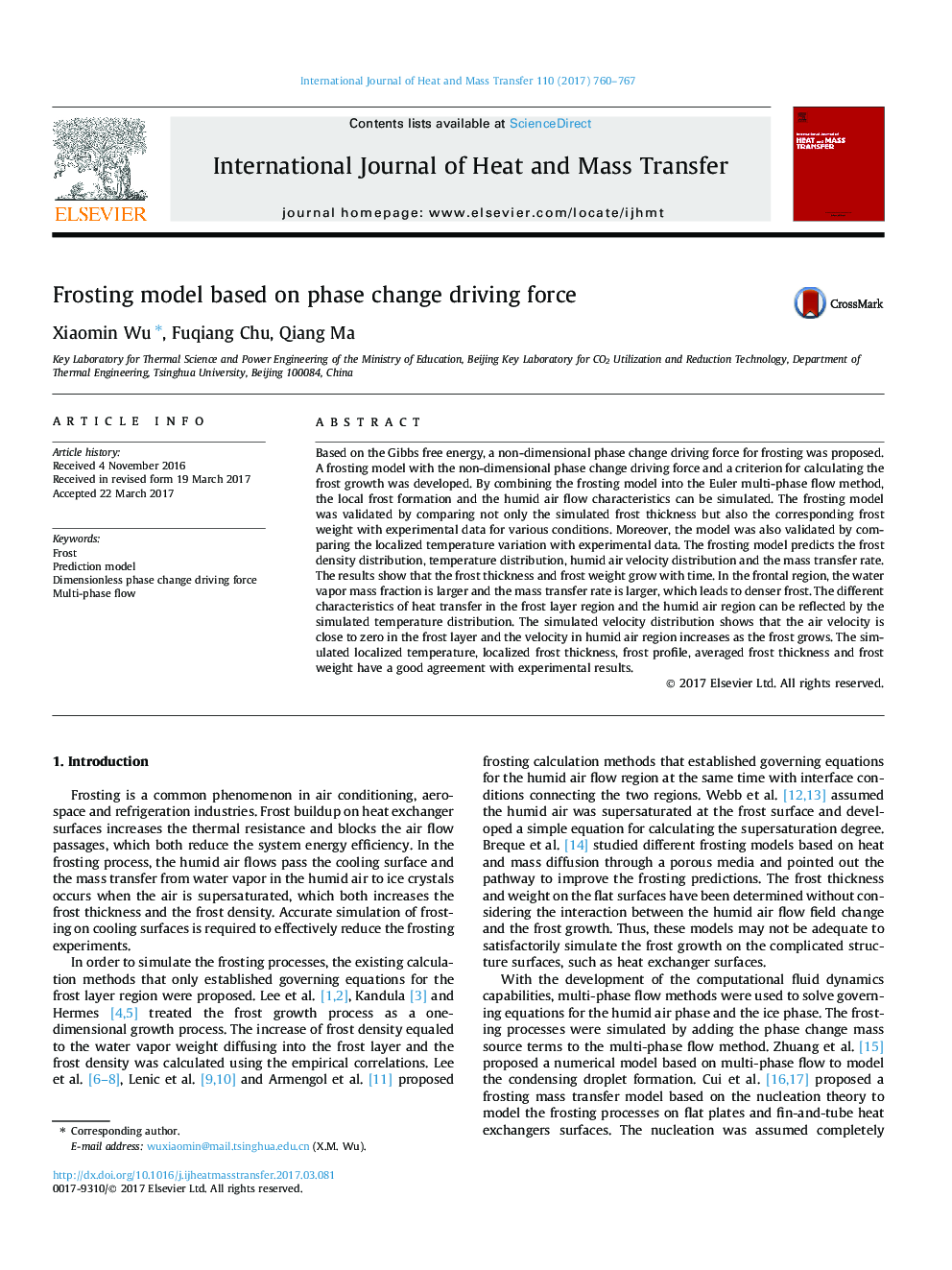| کد مقاله | کد نشریه | سال انتشار | مقاله انگلیسی | نسخه تمام متن |
|---|---|---|---|---|
| 4993605 | 1458031 | 2017 | 8 صفحه PDF | دانلود رایگان |
عنوان انگلیسی مقاله ISI
Frosting model based on phase change driving force
ترجمه فارسی عنوان
مدل یخ زدگی بر اساس نیروی محرکه تغییر فاز
دانلود مقاله + سفارش ترجمه
دانلود مقاله ISI انگلیسی
رایگان برای ایرانیان
کلمات کلیدی
یخ زده، مدل پیش بینی، نیروی محرکه تغییر اندازه فاز، جریان چند فاز،
ترجمه چکیده
بر اساس انرژی آزاد گیبز، نیروی محرک تغییر فاز غیرمستقیم برای سرامیک پیشنهاد شد. مدل یخبندان با نیروی محرک تغییر فاز غیرمستقیم و معیار برای محاسبه رشد یخبندان توسعه یافت. با ترکیب مدل یخبندان به روش جریان چند فازی یولر، شکل گیری یخ زدگی محلی و ویژگی های جریان رطوبت هوا می توانند شبیه سازی شوند. مدل یخ زدگی با مقایسه ضخامت یخ زده شبیه سازی شده و همچنین میزان یخ زدگی مشابه با داده های تجربی برای شرایط مختلف مورد تایید قرار گرفت. علاوه بر این، مدل نیز با مقایسه تغییرات دمای محلی با داده های تجربی معتبر بود. مدل یخ زدگی توزیع تراکم یخ، توزیع دما، توزیع سرعت مرطوب هوا و میزان انتقال جرم را پیش بینی می کند. نتایج نشان می دهد که ضخامت یخ زده و وزن یخبندان در طول زمان افزایش می یابد. در ناحیه پیشانی، کسر حجمی بخار آب بیشتر است و میزان انتقال جرم بزرگتر است که منجر به یخ زدگی شدیدتر می شود. ویژگی های مختلف انتقال حرارت در منطقه لایه یخ زده و منطقه ی مرطوب هوا می تواند با توزیع درجه حرارت شبیه سازی شده منعکس شود. توزیع سرعت شبیه سازی شده نشان می دهد که سرعت هوا در لایه یخ زدگی نزدیک به صفر است و سرعت آن در منطقه ی مرطوب افزایش می یابد چون یخ زدگی ها رشد می کنند. دمای محلی شبیه شده، ضخامت یخ زدگی محلی، مشخصات یخ زدگی، ضخامت یخبندان و وزن یخبندان به طور میانگین، با نتایج آزمایش همخوانی خوبی دارد.
موضوعات مرتبط
مهندسی و علوم پایه
مهندسی شیمی
جریان سیال و فرایندهای انتقال
چکیده انگلیسی
Based on the Gibbs free energy, a non-dimensional phase change driving force for frosting was proposed. A frosting model with the non-dimensional phase change driving force and a criterion for calculating the frost growth was developed. By combining the frosting model into the Euler multi-phase flow method, the local frost formation and the humid air flow characteristics can be simulated. The frosting model was validated by comparing not only the simulated frost thickness but also the corresponding frost weight with experimental data for various conditions. Moreover, the model was also validated by comparing the localized temperature variation with experimental data. The frosting model predicts the frost density distribution, temperature distribution, humid air velocity distribution and the mass transfer rate. The results show that the frost thickness and frost weight grow with time. In the frontal region, the water vapor mass fraction is larger and the mass transfer rate is larger, which leads to denser frost. The different characteristics of heat transfer in the frost layer region and the humid air region can be reflected by the simulated temperature distribution. The simulated velocity distribution shows that the air velocity is close to zero in the frost layer and the velocity in humid air region increases as the frost grows. The simulated localized temperature, localized frost thickness, frost profile, averaged frost thickness and frost weight have a good agreement with experimental results.
ناشر
Database: Elsevier - ScienceDirect (ساینس دایرکت)
Journal: International Journal of Heat and Mass Transfer - Volume 110, July 2017, Pages 760-767
Journal: International Journal of Heat and Mass Transfer - Volume 110, July 2017, Pages 760-767
نویسندگان
Xiaomin Wu, Fuqiang Chu, Qiang Ma,
